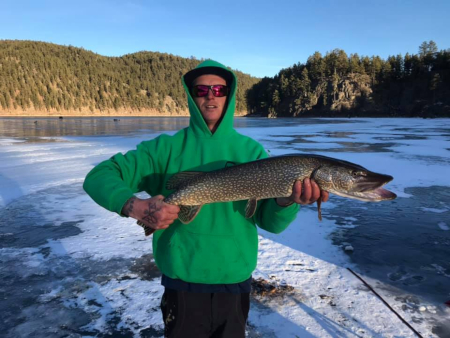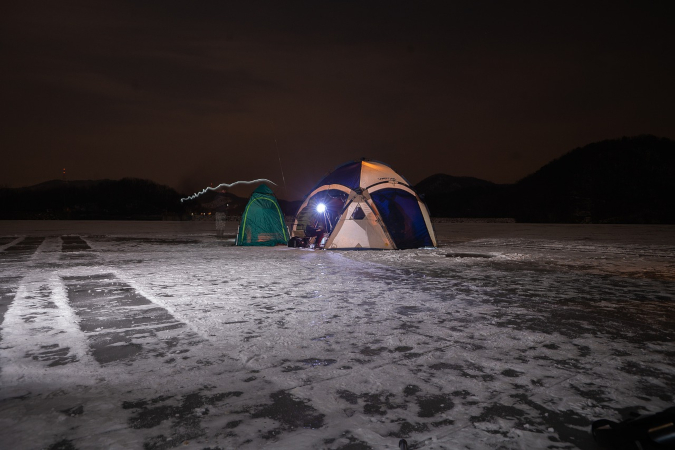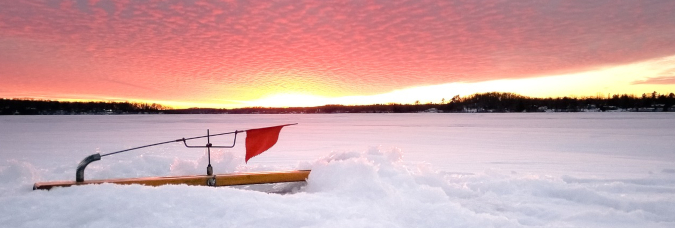 Northern pike are one of the greatest fish to chase during the winter months. They stay active all winter long, they fight aggressively, and they can grow as long as two feet and weigh as much as 60 pounds. These fish are really the Kings of the North and when it comes to ice fishing, I believe they’re the target on everyone’s mind.
Northern pike are one of the greatest fish to chase during the winter months. They stay active all winter long, they fight aggressively, and they can grow as long as two feet and weigh as much as 60 pounds. These fish are really the Kings of the North and when it comes to ice fishing, I believe they’re the target on everyone’s mind.
These guys are also at the top of the food chain so they tend to take over any lake. They’re not the “best” eating because of the bones but if you can get past the extra work, they have a fresh clean taste because of the stillness of the winter water under the ice.
There are two primary keys to catching northern pike under the ice:
- Understanding where to drop your lure
- Understanding how to present it (and what to present)
Okay, so it’s more like three things but if you can grasp these points you’ll never have a hard time catching the pike you want rather than the smaller ones that just clog up your fishing time and make you work harder than you’d like.
Let’s take a look at some of the things you’ll want to do this winter when you hit the ice.
Picking The Best Lake
The first thing you’ll have to decide is where you want to fish. You have two important decisions here. You can choose the lake or pond known for hot numbers, tons of action, and a lot of fun.
Or, you can chase after the trophy fish and go for the lake that might not even give you a nibble all day. Looking towards local DNR reports and information from talking with other anglers is the way to go.
In Northeast PA we have a very “popular” bait shop. The quotes are there because it’s only popular to certain people so it’s actually not very popular at all… if you get what I’m saying.
Anyway, the owner of the shop puts out reports in a newspaper style bin outside of his store a few times a year talking about the latest news and trends in the local fishing game. He charges for them but I’ll tell you what, it’s worth the $5.00 you’ll spend because you’ll learn more from this silly two-page report than you will anywhere else.
This is the type of advantage you need. I can’t tell you what lake to choose because I don’t know where you live. The best way to figure that out is by word of mouth.
Choosing Where To Drill
Now that the hard part is out of the way, you’re on the ice and need to know where to drill. Keep in mind that pike are ambush predators and their camouflage is what makes them such a dominant threat. They can hide well in vegetation so they’ll typically mull around weed beds and submerged greenery.
You’ll almost never find these guys in open water. They’re always hanging around some type of structure whether it’s weeds, drop-offs, or rock piles. That’s where you’ll find them.
That is the primary reason why I recommend having an ice fishing fish finder. These are essential to finding the hot spot before you drill your hole. By doing this, you’re saving yourself the time and aggravation of having to shop around the ice to figure out where the fish are hiding.
Obviously, the fish finder will not tell you if there are pike under the ice but a high-quality one will help you determine the type of structure where pike would hide and that’s where you stand the best chance of dropping your lure. Make sure you have a durable ice auger as well to make drilling the hole easier.
Finding Northern Pike Under The Ice
Alright, now you’ve got your hole drilled, you know there are pike under there, how do you locate them? As mentioned, large weedy areas are the best places to look for pike and they’re pretty active through the early ice fishing season and even at the peak.
Pike feed on panfish, shiners, suckers, and other small fish and this will continue until the water is too cold. During this time, the panfish move to deeper water, and the pike fishing slows down.
Your best bet is to fish pike in the early season right when the ice is thick enough to safely stand on and drill. Of course, this will vary based on your location, and ice fishing has been tough the past few years where I live.
In Northeast PA, many of the larger lakes haven’t frozen over enough to permit safe ice fishing so the season has taken a major hit. Thankfully, this year is a different story due to steady below freezing temperatures. That said, safety first. Don’t push your luck on some ice that isn’t thick enough.
Techniques and Presentations
The most popular way to fish for northern pike is with a tip-up but I’ll get into that shortly. It needs its own section and not everyone is capable of doing that. If you’re not an experienced ice angler and you’re just giving it a try, you can catch pike no problem without a tip-up.
Jigging is the next best method and most people will use sinking lures like shiner diving crankbaits or spoons. These are great because the presentation is aggressive with a lot of bright shining action.
You’ll want to size up to at least a three or four-inch lure because you want to avoid drawing too much attention from smaller fish. Increasing the size will increase your chances of finding a larger pike which is what I believe we’re all looking for. Plus, you’ll end up with more bites because the fish are feeding aggressively during this time so they’re looking for larger meals.
Go with a 10 pound mono or 20 pound braided for this. If you’re using braided line you’ll want to have a fluorocarbon or steel leader. I’ve gotten away from steel leaders because I think they impact the presentation and most line is made now to handle freezing water without becoming brittle and stiff.
If you have a fish finder, this will help you here as well because you’ll be able to determine the ideal diving depth for your lure. You can let the lure drop and jig it one foot at a time, let it drop again, then repeat the process. Expect the pike to strike it when it becomes motionless so it’s okay to pause in between jigs.
Using Tips Ups for Northern Pike
As mentioned, tip-ups have likely produced more pike than any other method so I couldn’t go without discussing this strategy. Tip-ups also allow you to hold as many positions as you can manage which increases your chances so that could have something to do with the success as well.
Make sure you’re using a freeze-resistant line because it’s not going to move much and use a high-quality sinker and snap swivel because you’ll have to change the leader out.
I only use live bait for tip-ups because you need something that will create its own presentation. Shiners and suckers are most popular but dead bait works for pike as well because they feed so heavily.
Final Thoughts
I suggest using tip-ups and jigging for the ultimate combination. There’s nothing more exciting than battling a huge northern pike so you won’t want to miss out on that opportunity. I also think ice fishing can be a great activity for the whole family so get out there and chase some northern pike; you never know what might happen!
Author: Coty Perry at https://yourbassguy.com
Coty is a third-generation angler with 20 years of experience chasing fish through the murky muddy waters of Northeast PA.
